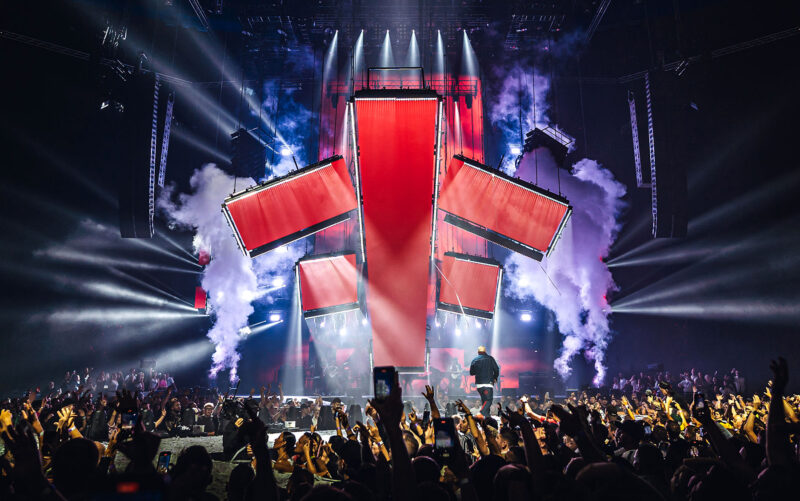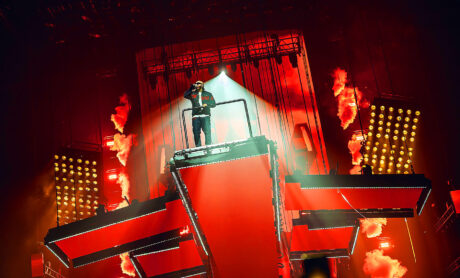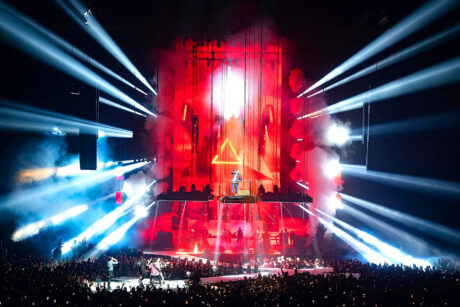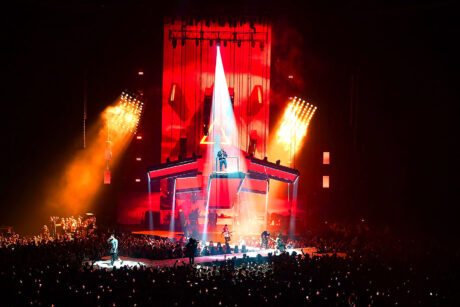
Show Designer and Director Martin Hruska wanted to create a sense of spectacle coupled with edginess and idiosyncrasy for Slovak rap star Kontrafakt’s two much-anticipated, high-profile New Eras concerts which were staged at Prague’s O2 Arena. Kontrafakt was celebrating two decades at the cutting edge of rap, so Hruska, the artist and event producers Mafia Records were on a mission to “present the biggest and most memorable show possible” in that venue, explained Hruska, outlining his ambitious visual aesthetic for which he also leaned heavily into Kinesys automation.
 The specialist technical discipline of automation was utilized to dramatically shift the architecture and vibes of the performance space throughout the show, all the time ensuring that the artist, who has a great connection with his fans, remained right at the center of the action. Hruska asked automation specialist Kosma Szostak and his company Showstak, based in Poland, onboard to assist in realizing this epic element of the production, which was delivered with the help of 48 x 1 ton and half ton Kinesys motors. These were a mix of Apex hoists and EXE hoists running with Kinesys Elevation 1+ drives, with inbuilt load cells plugged into a Kinesys Libra PRO system and safety-under-load / overload cut offs linked to a Kinesys Mentor 4 unit.
The specialist technical discipline of automation was utilized to dramatically shift the architecture and vibes of the performance space throughout the show, all the time ensuring that the artist, who has a great connection with his fans, remained right at the center of the action. Hruska asked automation specialist Kosma Szostak and his company Showstak, based in Poland, onboard to assist in realizing this epic element of the production, which was delivered with the help of 48 x 1 ton and half ton Kinesys motors. These were a mix of Apex hoists and EXE hoists running with Kinesys Elevation 1+ drives, with inbuilt load cells plugged into a Kinesys Libra PRO system and safety-under-load / overload cut offs linked to a Kinesys Mentor 4 unit.
All the hoists were programmed and run via Kinesys Vector control. With a set up window for the full production of only 9 hours ahead of the first show, it was imperative that the automation was practical, achievable, and reliable, and Kinesys provided an excellent solution. The show concept featured three main moving elements. The first was a 14-meter-long by 10-meter-wide flown catwalk which morphed – with the addition of four flanking pieces or pods – into a massive double headed cross, mimicking the Kontrafakt logo. The catwalk flew in and out and tilted in various directions at strategic points through the show, above a right-angled dual runway below, with two catwalks protruding over 25 meters into the audience in two directions, and both ends shaped into double headed crosses. The flying catwalk was designed in conjunction with the four flanking ‘cross’ section set elements on the upstage sides.
In the penultimate song, “Farewell Kiss”, the whole catwalk tipped to a 45-degree position with the four cross elements folding out fully to form the double headed Kontrafakt cross, with the artist standing at the top of the centerpiece, leaving everyone in the room gripped with the drama and excitement of this incredible move. When folded, the cross was the size of a small house at 14 x 10 m (46′ x 33’), with a P4 LED screen cladding the underside, and Robe Tetra2 and Tetra1 moving LED batten lighting fixtures outlining the perimeters. Four FORTE moving lights and significant amounts of pyro were rigged to the upper parts. The whole piece weighed around 4 tons and required smooth and accurate control to achieve the complex moves that Hruska wanted to keep the narrative and momentum rolling throughout the 2-hour show.

The long catwalk section was flown and moved using six Kinesys Apex 1,250kg motors with pick up points carefully positioned to enable equal load distribution to maintain stability and maximize the movement control. “A significant advantage of the Kinesys automation system in this context was its capability to manage load distribution effectively while tilting the catwalk,” explained Kosma. This was vital as the catwalk underwent the most dynamic tilting movements. The load distribution also needed meticulous control to ensure the safety of the artist as well as maintaining the overall integrity of the structure. The four cross pods were each flown with four EXE 500kg and 1000kg motors with Kinesys Elevation 1+ drives, giving a total of 16. The upstage ones were loaded with four moving lights each and all four pods were outlined with the Tetra2 LED battens. The structures were constructed by Czech companies Alunad and Black Stages.
Precision cueing played a pivotal role in all these moving parts. Carefully synchronizing the movement of each motor and closely monitoring the weight distribution allowed Kosma and his team to ensure all Hruska’s creative goals could be met with the utmost safety. Also automated and controlled via the same Kinesys Vector system was a grid of 9 upstage-downstage orientated lighting trusses flown above the main stage area and integral to Hruska’s set / stage design. They moved in and out creating different structural shapes as the show progressed. Each lighting truss was rigged on two EXE half ton / Kinesys Elevation 1+ motors, making up the total of 48 hoists used in the system.
For the show, Hruska worked smartly with the automation to build the desired dramaturgy and storyboard, dividing the movement into two basic types. Firstly, moving the lighting trusses which generally shaped the scenography, then the catwalk / cross movements which were much more extreme, thrilling, and amazing with their sheer size and dramatic elevation of the artist.
Nothing moved at all until halfway through the concert, and then things started subtly with some positional changes to the lighting trusses. Then the catwalk was introduced with the artist and musicians on it, and this built to the finale of the concert with big catwalk moves and transformations as the cross pieces came into play and all these elements angled out and tilted to face the audience. Then, as mentioned above, during “Farewell Kiss” the full ramp / cross transition was revealed with Kontrafakt standing high above the audience in celestial-like exaltation, accompanied by a massive extravaganza of pyro.
 Automation was programmed by Kosma and Maksymilian Łempicki and run by Maksymilian, with all the cues – over 16 in total – crafted by Hruska as he developed the look, style, and narrative arc of the show for the artist, his band, and special guests. Chief rigger for the shows was Jan Springet, and Simon “Captain” Howdy crew chiefed the Showstak automation crew of six and was the Vector console assistant. All production departments were coordinated and overseen by Kontrafakt’s production manager, Cyril Hořánek, and Hruska’s design assistant for the project was Michal Azozda.
Automation was programmed by Kosma and Maksymilian Łempicki and run by Maksymilian, with all the cues – over 16 in total – crafted by Hruska as he developed the look, style, and narrative arc of the show for the artist, his band, and special guests. Chief rigger for the shows was Jan Springet, and Simon “Captain” Howdy crew chiefed the Showstak automation crew of six and was the Vector console assistant. All production departments were coordinated and overseen by Kontrafakt’s production manager, Cyril Hořánek, and Hruska’s design assistant for the project was Michal Azozda.
“Working with Martin on these shows was a brilliant experience,” stated Kosma. “He knew what he wanted, and we delivered a robust and reliable automation solution with precision control for the safe and seamless movement of the cross and other moving aspects,” says Kosma, “which involved detailed planning, engineering and testing to guarantee a flawless delivery.” One of the best-known designers in the Czech Republic, Hruska had a blank and proposed a multi layered stage set with a ground-based section that was shaped like Kontrafakt’s interesting and asymmetric signature symbol with two crosses.
The creative journey started about a year ahead of the gigs, and as the scenic elements evolved, Hruska started thinking about the imagineering lighting fixtures and what he wanted to achieve in terms of effects for different sections of the show.
Kosma has been using Kinesys products since 2011. When it came to setting up and establishing Showstak, he knew it was a solid investment, and that the control systems are versatile and will also work for the many custom and turn-key projects that they design and build.
Further information from Kinesys: www.kinesysusa.com
Photos courtesy of Martin Hruska


